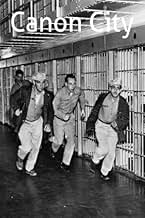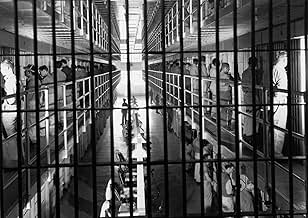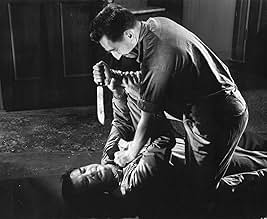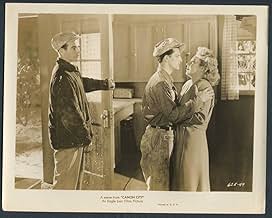Adicionar um enredo no seu idiomaTwelve inmates plan a prison break from the Colorado State Penitentiary but one of them reluctantly joins the group.Twelve inmates plan a prison break from the Colorado State Penitentiary but one of them reluctantly joins the group.Twelve inmates plan a prison break from the Colorado State Penitentiary but one of them reluctantly joins the group.
- Direção
- Roteirista
- Artistas
Reed Hadley
- Narrator
- (narração)
Avaliações em destaque
This movie proudly bears the label of a semi-documentary and comes complete with the usual Foreword about all the incidents being portrayed exactly as they happened, and all photographed on their actual locations, using real warders, guards and convicts, etc.
Personally, I doubt that the movie was shot in its entirety inside the actual prison there's even a credit for 2nd unit direction and photography. But be this as it may, the studio material is certainly extremely well integrated with the location footage. Credit for this achievement is mostly due to John Alton, whose masterful photography makes Canon City must watching for connoisseurs. True, Alton's work here is less tantalizing than usual as he was required to match up his shots with Strenge's rather dull location work. Nonetheless, there are still more than a few indications (the profile silhouette on Brady's face) of genius behind the camera.
Crane Wilbur's screenplay is less praiseworthy, but typical of that writer's detached, tabloid newspaper-style approach. He loves the sort of narrated rhetoric employed by contemporary newsreel commentators (Reed Hadley does a good job here with the actual narration), but fortunately his dialogue is less flowery and more realistic.
Generally Wilbur's direction rates as rather dull, but here his handling is even occasionally inventive, although his experiments are not always successful (as for example in the oddly oblique use of the first-person camera right at the beginning, with the on-screen characters swapping words with the disembodied narrator).
In all, however, the film emerges as a reasonably engrossing prison melodrama, convincingly acted (except oddly by the non-professionals), compellingly photographed, and tautly written. Despite its foregone conclusion, the storyline does build up a moderate amount of excitement and tension.
Personally, I doubt that the movie was shot in its entirety inside the actual prison there's even a credit for 2nd unit direction and photography. But be this as it may, the studio material is certainly extremely well integrated with the location footage. Credit for this achievement is mostly due to John Alton, whose masterful photography makes Canon City must watching for connoisseurs. True, Alton's work here is less tantalizing than usual as he was required to match up his shots with Strenge's rather dull location work. Nonetheless, there are still more than a few indications (the profile silhouette on Brady's face) of genius behind the camera.
Crane Wilbur's screenplay is less praiseworthy, but typical of that writer's detached, tabloid newspaper-style approach. He loves the sort of narrated rhetoric employed by contemporary newsreel commentators (Reed Hadley does a good job here with the actual narration), but fortunately his dialogue is less flowery and more realistic.
Generally Wilbur's direction rates as rather dull, but here his handling is even occasionally inventive, although his experiments are not always successful (as for example in the oddly oblique use of the first-person camera right at the beginning, with the on-screen characters swapping words with the disembodied narrator).
In all, however, the film emerges as a reasonably engrossing prison melodrama, convincingly acted (except oddly by the non-professionals), compellingly photographed, and tautly written. Despite its foregone conclusion, the storyline does build up a moderate amount of excitement and tension.
Filmed With The Naked Fury Of Fact! So screams the poster for this semi-documentary styled pic. Barely a year previously a dozen prisoners escaped from the Colorado State Penitentiary, Canon City, this is the story of that break and subsequent hunt for the escapees.
Written and directed by Crane Wilbur, it stars Scott Brady, Jeff Corey and Whit Bissell. Cinematography is by John Alton and Reed Hadley provides the stentorian narration. Plot is exactly what it says on the cover, men escape prison and as a blizzard rages outside they encounter various members of the public whilst trying to escape capture.
The various convict character splinters, as we follow the principal escapees, makes for suspenseful scenes as they impose themselves on the homes of good honest folk. The moral dilemma heartbeat comes via Brady's Jim Sherbondy, a man who was reluctant to escape but ultimately got caught up in the whirlpool. The characterisations are standard for this type of picture, but well performed all the same, with Corey particularly striking as a weasel type. The various women in the story are well written, proving to be of strong will and minds, while Alton and Wilbur enhance the fatalistic mood with low lights and close ups.
A decent pic from the pantheon of prison noir, but not a patch on the likes of Brute Force and Riot In Cell Block 11. 6/10
Written and directed by Crane Wilbur, it stars Scott Brady, Jeff Corey and Whit Bissell. Cinematography is by John Alton and Reed Hadley provides the stentorian narration. Plot is exactly what it says on the cover, men escape prison and as a blizzard rages outside they encounter various members of the public whilst trying to escape capture.
The various convict character splinters, as we follow the principal escapees, makes for suspenseful scenes as they impose themselves on the homes of good honest folk. The moral dilemma heartbeat comes via Brady's Jim Sherbondy, a man who was reluctant to escape but ultimately got caught up in the whirlpool. The characterisations are standard for this type of picture, but well performed all the same, with Corey particularly striking as a weasel type. The various women in the story are well written, proving to be of strong will and minds, while Alton and Wilbur enhance the fatalistic mood with low lights and close ups.
A decent pic from the pantheon of prison noir, but not a patch on the likes of Brute Force and Riot In Cell Block 11. 6/10
A fine prison break movie from Crane Wilbur by way of Eagle-Lion Pictures, Canon City is a very good, tense film, based on a true incident, about a group of men who break of of the eponymous state prison, where the movie was also filmed. There is particular emphasis on two escapees, a reluctant one who is basically a decent guy, and a more aggressive one, who isn't. As portrayed by Scott Brady and Jeff Corey these characters come to life and compel our interest, and in Brady's case sympathy.
As photographed by the masterful John Alton, the picture is a pleasure to watch, as Mr. Alton was a master of light and shadow, and is obviously in his element with this dark story. He brightens things up in the end with a snowstorm, which enables the picture to end on a grace note, and even a feeling of optimism, not wholly justified by the events we have just witnessed.
As photographed by the masterful John Alton, the picture is a pleasure to watch, as Mr. Alton was a master of light and shadow, and is obviously in his element with this dark story. He brightens things up in the end with a snowstorm, which enables the picture to end on a grace note, and even a feeling of optimism, not wholly justified by the events we have just witnessed.
For anyone who enjoys mid-20th century movies, "Canon City" is a perfect choice. I had the good fortune to watch this movie in the wee hours of the morning, when old black-and-white movies are best viewed. Tension abounds in this surprisingly gripping story. That it's based on real events and filmed on location is a plus. If you have ever visited the Royal Gorge Bridge and tram in Colorado, you will enjoy the cat-and-mouse chase scene near the end of the movie. The women are heroic in this film, much more so than the men. With their calming words, warm food, hot cocoa, and hammer-wielding ways, they demonstrate courage in the face of danger. "Star Trek" fans will find a treat in the prisoner known as Smalley. He is played by DeForest Kelley, best known to Trekkies everywhere as Dr. Leonard "Bones" McCoy. "Canon City" is a thoroughly enjoyable film. Catch it on late-night TV if you can.
Canon City (1948)
A simple loud warning up front--the first twenty minutes or so is a horrible, stiff, documentary kind of lead-in to the movie proper. When the dramatic action gets going, it becomes fully a movie with suspense, character, speed, and even at times complexity. In fact, you could even fast forward to where you see the buy in the jail cell doing a model of a ship.
The stuff before that is not needed. It tells us what we already know about prison, though it seems to use real inmates in brief interviews, as if to set up the later jailbreak as something more tangible and believable.
It isn't giving anything away to say that some inmates escape--that's the whole hook of the movie--and then what happens to each group or individual in their attempts to get out of Canon City is what drives the movie in a series of somewhat independent vignettes. The encounters with regular town people in their homes is a little contrived but also has the edge of fear to it, and suspense. It works pretty well, the cops gradually closing in on this or that escapee.
The end result is still almost a public relations piece about the prison system, about ordinary Americans who rise up and do heroic things, and about the different kinds of attitudes of the inmates, who are people after all. I actually liked the second half of the movie, even it it wasn't completely original or brilliant. The acting is meant to be believable in a vernacular kind of way, and it is. Give it a look, especially if you like prison flicks.
A simple loud warning up front--the first twenty minutes or so is a horrible, stiff, documentary kind of lead-in to the movie proper. When the dramatic action gets going, it becomes fully a movie with suspense, character, speed, and even at times complexity. In fact, you could even fast forward to where you see the buy in the jail cell doing a model of a ship.
The stuff before that is not needed. It tells us what we already know about prison, though it seems to use real inmates in brief interviews, as if to set up the later jailbreak as something more tangible and believable.
It isn't giving anything away to say that some inmates escape--that's the whole hook of the movie--and then what happens to each group or individual in their attempts to get out of Canon City is what drives the movie in a series of somewhat independent vignettes. The encounters with regular town people in their homes is a little contrived but also has the edge of fear to it, and suspense. It works pretty well, the cops gradually closing in on this or that escapee.
The end result is still almost a public relations piece about the prison system, about ordinary Americans who rise up and do heroic things, and about the different kinds of attitudes of the inmates, who are people after all. I actually liked the second half of the movie, even it it wasn't completely original or brilliant. The acting is meant to be believable in a vernacular kind of way, and it is. Give it a look, especially if you like prison flicks.
Você sabia?
- CuriosidadesFilm debut of Scott Brady.
- Erros de gravaçãoImmediately after the prison break, there's a shot of a crowd of people leaving a movie theatre, with Abbott & Costello in 2 Prontos de Sorte (1948) (another Eagle-Lion release) prominently displayed on the readerboard. Only problem is, the break took place 30 December 1947, and The Noose Hangs High wasn't released until the end of the following April.
- ConexõesReferenced in Let's Go to the Movies (1949)
Principais escolhas
Faça login para avaliar e ver a lista de recomendações personalizadas
Detalhes
Bilheteria
- Orçamento
- US$ 424.000 (estimativa)
- Tempo de duração1 hora 22 minutos
- Cor
- Proporção
- 1.37 : 1
Contribua para esta página
Sugerir uma alteração ou adicionar conteúdo ausente



































